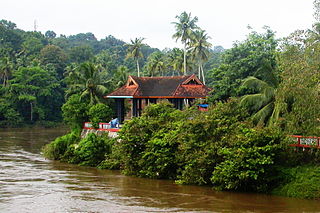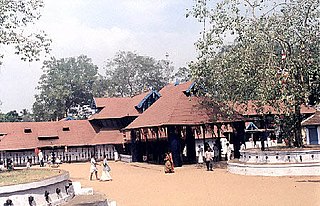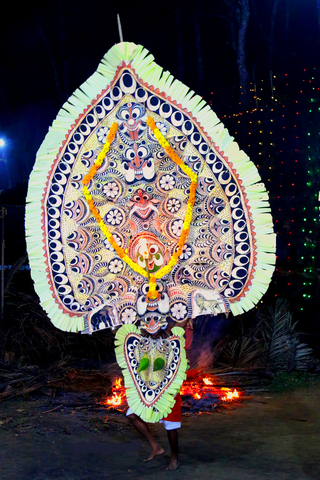
Neelamperoor Padayani is a Padayani conducting in Neelamperoor Palli Bhagavathi Temple in Neelamperoor, Alappuzha district, Kerala, India. It is conducting on the pooram day after Thiruvonam in the month chingam for 16 days. [1]

Neelamperoor Padayani is a Padayani conducting in Neelamperoor Palli Bhagavathi Temple in Neelamperoor, Alappuzha district, Kerala, India. It is conducting on the pooram day after Thiruvonam in the month chingam for 16 days. [1]
The word Padayani means line of infantry. The name Padayani arrived due to the line formation of people like troops. [1]
The mythology of Neelamperoor padayani lies with Cheraman Perumal myths. It is believed that it was started after the arrival of king Cheraman Perumal in Neelamperoor.
It is believed that this festival had the history of centuries. This consists the cultures of Hinduism and Buddhism.[ citation needed ] Chinese traveller Fa-Hien depicted that this festival resembles a festival of Buddhists in Patna in his travelogue.[ citation needed ]
Neelamperoor Padayani has some difference from other Padayani performances held in the temples in Kerala. The key feature of this festival is the procession of effigies. They include the figures of animals like swans, elephants, etc. and deities such as Bhima, Ravana, Yakshi, etc. as an offering to the goddess. These decorated effigies shows the craftsmanship of artists in Kerala. The padayani begins in thiruvonam day and end with pooram day which is celebrated as the birthday of Bhagavathy (goddess). As per the rituals, the padayani is started with a symbolic sanction of Cheraman Perumal in the western side of Bhagavathy temple. Devotees march towards the monument of Perumal with lit torches of coconut leaves. This ritual longs for four days. [2]
This days are followed by Kudapadayani which consists of floral decorations in umbrella made from the stems of coconut leaves. The next four days effigies made up of jackfruit leaves are offered to the deity. The last two days are of effigies of swan which is made up of plantain stems and slender leaves of coconut trees with ixora floral decorations. The highlight of the last day is 45 feet long swan effigy. [2]
Thothakali, a rhythmic dance performed in front of the fire accompanied by drumbeats and traditional music is another part of Neelamperoor Padayani. [2]

The ChottanikkaraDevi Temple is a temple dedicated to the Hindu mother goddess Bhagavati Lakshmi. She is believed to be residing in Chottanikkara (Mahalakshmi) along with her Husband Maha Vishnu. The main deity is also considered as Lakshmi Narayana according to the temple legend. The temple is Classified one among the 108 Abhimana Kshethram of Vaishnavate tradition. The temple is located at Chottanikkara, a southern suburb of the city of Kochi in Ernakulam district, in the state of Kerala, India and is one of the most popular temples in the state. The temple is also known for conducting exorcism.

Bhadrakali is a Hindu goddess. She is considered to be the auspicious and fortunate form of Adi Shakti who protects the good, known as Bhadra.

Koodalmanikyam Temple is a Hindu temple in Irinjalakuda Municipality, Thrissur district, Kerala, India. The temple comprises a main structure, a walled compound with citadels, and four ponds around the main structure one of which is within the walls. Koodalmanikyam Temple is the only ancient temple in India dedicated to the worship of Bharata, of Rama, however the idol is that of god Vishnu. "Sangameshwara" is another name associated with the deity at Koodalmanikyam. The temple is one of four in Kerala that form a set called "nalambalam", each temple dedicated to one of the four brothers in the epic Ramayana: Rama, Bharata, Lakshmana and Shatrughna.

Garudan Thookkam is a ritual art form performed in certain Kali temples in some Central Kerala districts in south India. The people who dress up as Garuda perform the dance. After the dance performance, the hang-designate dangle from a shaft hooking the skin on his back. In some places, the ritual is performed colorfully with Garudas taken in a procession on bullock carts or boats or hand pulled carts. It will be available in Devi temple during the festival of Meena bharani and Pathamudayam in Thiruvanchoor in Kottayam district.

The Kodikkunnu Bhagavathy Temple or Kodikkunnu Ambalam is an ancient Hindu temple dedicated to the goddess Bhadrakali located in the village of Pallippuram, near Pattambi, in Palakkad district of Kerala, India.

Sarkaradevi Temple is one of the most important temples in South India. It is situated Chirayinkeezhu town in Thiruvananthapuram district. Tradition accords a remote antiquity to this temple. Its main deity is Bhadrakali. The Sarkaradevi Temple assumed a significant status for many reasons and rose to historical importance mainly with the introduction of the famous Kaliyoot festival by Anizham Thirunal Marthanda Varma, the Travancore sovereign, in 1748. The Sarkaradevi Temple have some basic attachment with Nakramcode Devi Temple which located in Avanavanchery, Attingal.

Neelamperoor Pally Bhagavathi Temple is a 1700 year old Buddhist temple which was later converted to a Bhagavathy temple in Neelamperoor, in Kottayam, Kerala, India situated in kuttanadu Alappuzha. It is about 3 km west of Kurichy outpost in Kottayam-Changanacherry Main Central Road. The principal deity is Vanadurga.

The oldest pooram in all of Kerala, the Arattupuzha Pooram is held at the Sree Sastha Temple in Thrissur for a period of seven days each year. Believers say that at this 'conclave', all Gods and Goddesses gather during the time period of the Pooram. Arattupuzha Temple in Arattupuzha, Thrissur district of Kerala. Visitors from nearby and far off places reach the village of Arattupuzha during the festival days. The pinnacle of the seven-day festival is the last two days. The evening prior to the last day of the festival would have an assembly of caparisoned elephants and staging of percussion ensembles as part of the ceremony called Sasthavinte Melam. The pancharimelam of Aarttupuzha Sasthavu is the largest assembly of percussion artists in any other night Poorams. More than 200 artists perform in sasthavinte melam. This can only be seen at Sree Poornathrayeesa Temple, Tripunithura other than in Arattupuzha Pooram

Chettikulangara Sree Bhagavathi temple is one of the most renowned Hindu temples in Kerala. Main deity is Sree Bhadrakali. The temple is located at Chettikulangara in Mavelikkara taluk near kayamkulam city of Alappuzha district in the Indian state of Kerala. The temple is situated about 4 kilometres (2.5 mi) west of Mavelikkara town, 7 kilometres (4.3 mi) north of Kayamkulam city on SH6. Bhadrakali, is an incarnation of supreme mother Shakthi devi, born from the third eye of Lord Shiva, to kill the demon king Daruka. 'Bhadra' means good and 'Kali' means goddess of time. So Bhadrakali is worshipped for prosperity and salvation. Devi is considered as the creator, protector, destructor, nature, power and Kundalini shakthi. Chettikulangara is located near Kayamkulam city. Chettikulangara is in kayamkulam legislative assembly.

Thazhoor Bhagavathy Kshetram is a 300-year-old Hindu temple on the banks of the Achankovil river in Vazhamuttom, Pathanamthitta District in Kerala. The Devi (goddess) is the main deity here. The centuries-old temple was fully reconstructed in 2020.
Pazhayannur is a town and panchayath in Thrissur district, in the state of Kerala, India. The eminent mridangist, Palghat Mani Iyer was born here.

Peruvanam Pooram is one of the most popular temple festivals of the South Indian state of Kerala. It is held at Peruvanam Temple in Cherpu, Thrissur District. Lord Shiva is the presiding deity of this temple.
Sri Venkatachalapathy Temple is a temple situated in Trivandrum, Kerala, about a minute walk from the southern gate of Sri Padmanabhaswamy Temple. It is also known as Srinivasar kovil, Perumal Kovil, Iyyengar Kovil or Desikar Sannidhi. The temple was built in 1898. The poojas in Kerala temples are based on the Namboodiri sampradayam, except a few like this.

Sree Kurumba Bhagavati Temple is a Hindu temple at Kodungallur, Thrissur District, Kerala state, India. It is dedicated to the goddess Bhadrakali, a form of Mahakali or simply Durga or Aadi Parashakthi or Bhuvaneshwari worshipped and significantly revered in Kerala. The goddess is known also by the names "Sri Kurumba"". This temple is the head of 64 Bhadrakali temples in Kerala. This Mahakali temple is one of the oldest functioning temples in India. The goddess of the temple represents the goddess in her fierce ('ugra') form, facing North, featuring eight hands with various attributes. One is holding the head of the demon king Daruka, another a sickle-shaped sword, next an anklet, another a bell, among others. Routine worship at the temple every day at 03:00 and ends at 21:00 local time.

Kalampattu is a traditional performing art in Kerala, India.

Padayani, also known Padeni, is a traditional folk dance and a ritual art from the central portion of the Indian state of Kerala. A ceremonial dance involving masks, it is an ancient ritual performed in Bhagavati temples. The dance is performed in honor of Bhadrakaali. Meaning, a 'row of warriors', Padayani is an art form that blends all music, dance, theatre, satire, facial masks, and paintings. It is part of worship of Bhadrakali and is staged in temples dedicated to the goddess from mid-December to mid-May. Padayani is unique to central Travancore, comprising the Pathanamthitta and Kottayam districts of Kerala. It is also performed in adjoining regions of Kollam, Alappuzha districts.

The MajorVellayani Devi Temple is a highly revered shrine in Kerala, India, dedicated to goddess Bhadrakali. The shrine is situated in Vellayani 1.5 km west of Vellayani junction, 12 km southeast of Thiruvananthapuram on the eastern bank of Vellayani Lake. The temple is under the management of Travancore Devaswom Board. The temple structure has a bronze roof with traditional art work and carries Dravidian architecture. The temple has eastern and northern towers called Gopurams with statues of different Gods sculptured in them. The Gopurams function as gateways through the walls that surround the temple complex.

Chettikulangara Kumbha Bharani is a festival celebrated every year at the Chettikulangara Devi Temple, Chettikulangara, Alappuzha district, Kerala. It is held in the month of February or March, the date being determined according to the Malayalam Calendar. Chettikulangara Bharani in the Bharani nakshatra in the Malayalam month of Kumbha and hence the name Kumbha Bharani. Kuthiyottam and Kettukazhcha are the highlights of the festival. The festival is under consideration to be bestowed with the Intangible Cultural Heritage status by UNESCO.
This is a list of ancient Buddhist sites, relics, traditions and places from the Indian state of Kerala. Even though Kerala does not have any major presence of Buddhists in modern times, many historians recognize a Buddhist heritage that seem to have existed until the 10th century CE along with a widespread Sramana tradition of co-existence between Buddhism, Jainism and ancient Dravidian folk religion.
Although Buddhism in Kerala has almost disappeared, historians say that in ancient times Kerala had a strong position and its cultural influence can still be seen in the people of Kerala. It is believed that Buddhism reached Kerala in its infancy. There is historical evidence that Buddhist monks came to Kerala in the 6th century BC.